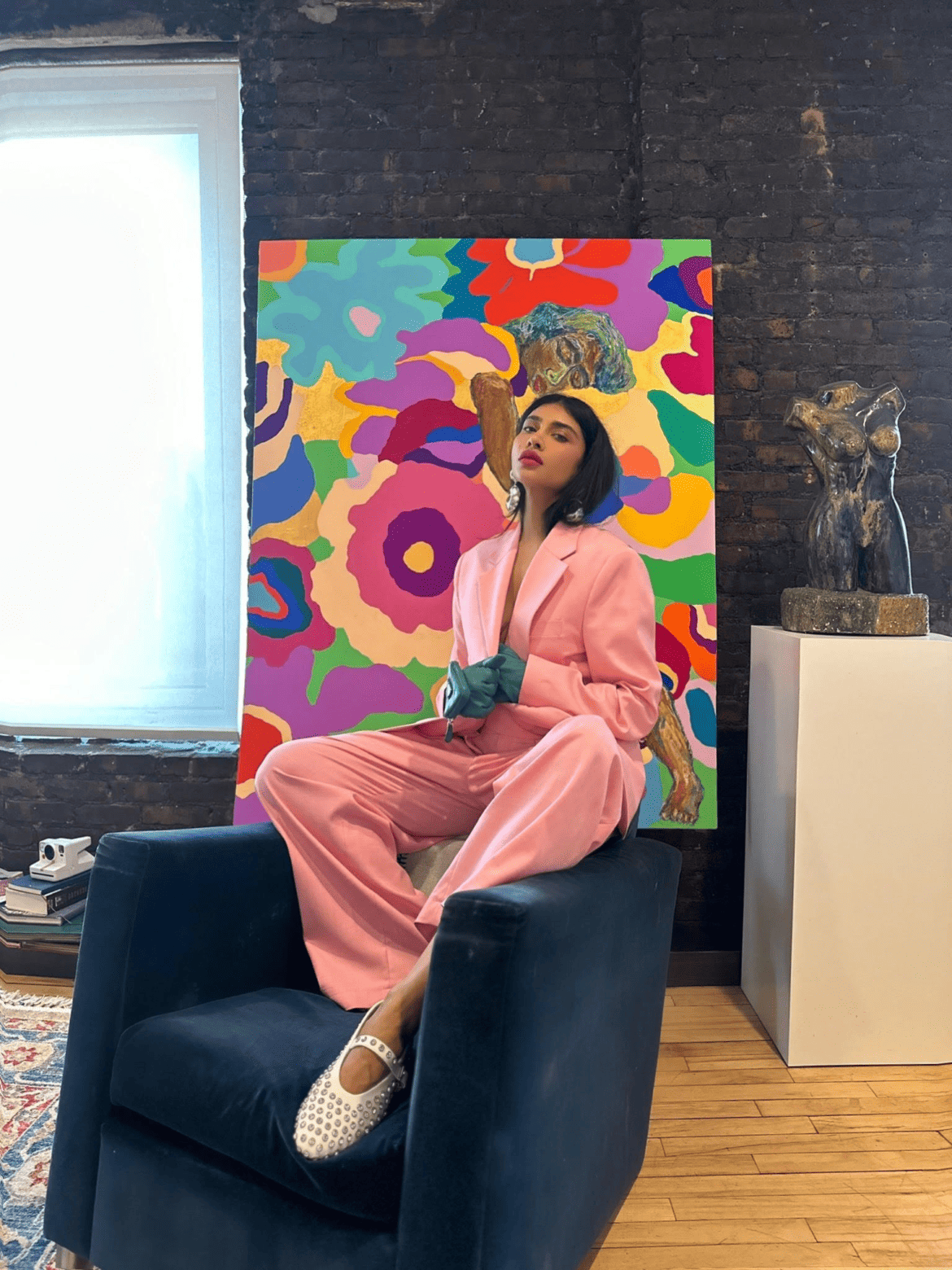In the vibrant world of art and fashion, Radhika Gupta-Buckley stands as a captivating figure, seamlessly merging her artistic mind with her distinctive sense of style. The New York based artist has been painting since the age of six, where her creativity is now bleeding into new facets of self-expression.
When did you first realize you wanted to be an artist?
My interest in art started early – I began painting when I was about six. Nevertheless, my family’s traditional Indian background led me on a different trajectory. I pursued a Law Degree from Oxford and subsequently engaged in legal practice, first at the UN in The Hague and later at the Indian Supreme Court. Yet, I grappled with the formidable bureaucratic obstacles hindering meaningful change. I felt totally powerless in my efforts to address the numerous issues and injustices plaguing India.
Amidst these challenges, I began finding refuge in painting, and one fine day, to the dismay and frustration of my parents, I decided to walk away from my legal career and dedicate all of my energy and time to art. In 2017, I proudly hosted my debut art exhibition, inaugurated by India’s Cultural Minister. This showcase featured nearly 30 pieces, each reflecting my life’s creative journey. The response was overwhelmingly positive, propelling me on a path where I’ve never looked back since.
How has your Indian heritage influenced your journey as an artist?
Coming from India, a nation rich in art, heritage, and culture, I am constantly drawn to these facets in my work. In the broadest sense, I am inspired by the country’s beauty. The art of encapsulating and narrating the Indian narrative fills me with tremendous enthusiasm. This passion is vividly evident in my protagonists and is expressed through a profound focus on the interplay of colors, textures, and intricate patterns.
What’s your process like, when creating a new piece of art?
My process of creating a new piece of art has evolved over the years. When I moved to NYC five years ago, my work was imbued with a longing for India. It wasn’t just about missing it; it was a deep yearning to understand it from a different perspective through the distant gaze of someone far away. In those pieces, I deliberately heightened certain elements and stylized the subjects, aiming to view them with the abstract clarity distance can provide.
My newer works are different. I feel a shift. They are more about looking outwards than inwards. The figures in these more recent paintings are fuller, larger, weightier, and messier. When they’re alone, they often crouch, turning in on themselves – looking for answers. They reach out, touching one another when they’re in pairs. In these double portraits, the subjects are similar in form but different in colors. There’s a sense of reunion. Of two parts becoming one whole. Of a return to self.
As an artist and mom, what does a day in your life look like?
Life’s a wild ride, but it’s the kind of crazy I adore. My two-year-old partner-in-artistic-crime, Fai Chaand, adds an extra layer of fun – even though he’s constantly attempting to give my paintings a toddler’s touch-up when he sneaks into my studio!
To keep my happiness intact, I’ve concocted a simple four-part recipe: family, work, exercise, and, of course, “me” time. We now have a Sunday tradition of visiting a new museum or art show every week. The joys of living in New York and seeing it through the eyes of a very curious two-year-old!
How does your personal style influence your choice of colors and themes in your artwork?
The way I dress and the art I create serve as the dual channels through which I express my identity and connection to the world. My style is a deliberate nod to my deep appreciation for aesthetics.
My style philosophy, much like my life philosophy, centers around challenging the established norms. I’d describe it, akin to my art, as a fusion of two fundamental sentiments: fearlessness and an unwavering commitment to my own voice. My fashion choices focus heavily on color and bold, exaggerated silhouettes, and I try to be unique in the way I put colors/prints and outfits together. I like a bit of madness; that’s what elevates a usual outfit into magic.
Has your fashion sense ever played a role in the way you approach a painting or the emotions you convey in it?
Life, for me, is a tapestry of colors and prints that interweave seamlessly. For instance, when I pair vibrant Cobalt Blue pants with an emerald green coat, it’s as if I’m instinctively driven to transfer that color palette onto my canvas, and the reverse holds true as well. Alternatively, a captivating print, whether on a dress or a teacup, can embed itself in my visual diary, only to resurface unexpectedly on my canvas at a later time.
What differentiates you and other artists?
Oh, good question … I think it’s a fusion of my background and how I integrate fashion into art. Hailing from India, a treasure trove of art, heritage, and culture, I’m perpetually drawn to these rich elements in my creative endeavors. In its broadest sense, I find my inspiration in the sheer beauty of the nation. Capturing and narrating the Indian story ignites an unbridled passion within me.
Tell us about some highlights in your career in fashion and art. What are some of your favorite projects you’ve created embodying the two?
Much like art, fashion is such a powerful way of self-expression and self-care. The clothes I choose are reflective of my current state of mind. Curating outfits is a form of self-dialogue, a means to articulate one’s inner self creatively.
One of my career’s recent highlights was the exhibition “Where the Wild Roses Grow” at the Kristin Hjellegjerde Gallery in Berlin. The magical backdrop for the show was the crumbling walls of an 18th-century castle. To feel powerful and pay homage to my roots, I chose to wear attire by Sabyasachi, the God of Indian Maximalism, to the opening. This ensemble, embellished with intricate embroidery, beading, and fur, served as a tribute to the artistry of India. It was a seamless complement to my art, merging the grandeur of Indian aesthetics with a spirit of contemporary renaissance.
Can you describe an outfit that makes you feel particularly creative or inspired?
When I studied Law at Oxford and practiced at the Supreme Court of India and the UN, I developed a deep affinity for the power suit. There’s something empowering about slipping into an oversized two-piece suit with sharp shoulders; it imparts a profound sense of purpose and confidence while also exuding a subtle allure. Now, distanced from the courtroom setting, I’ll often pair it with something unexpected, like a lace bra or bright pink heels and a red lip to inject femininity.
Beyond my penchant for androgynous attire, I also embrace a distinctly feminine style. I revel in donning white lace skirts and garments adorned with floral patterns, embracing a spectrum of pink shades that span the entire spectrum of the sun. This preference is almost a form of innocuous protest, challenging patriarchal norms.
Are there any specific artists or art movements that inspire your fashion choices?
They’re a lot of artists and movements I admire and respect. I naturally gravitate towards Surrealism and Dada, but I don’t internationally take inspiration from anyone. I want to stick to my own taste and mind, so I rely on my intuition for all paintings.
In terms of fashion, I love the 70’s- bellbottoms. floral prints, maxi dresses, and of course, a heavy dose of Bollywood opulence. I grew up in India, studied in the UK, and worked in the Hague before moving to New York about five years back, so I’ve developed a very individualistic style language that encapsulates the complex mix of my different life experiences.
Are there any fashion designers or brands that you admire for their artistic approach to clothing?
Schiaparelli holds a special place in my heart. Elsa’s boundless creativity and groundbreaking vision formed a perfect union of art and fashion. Her introduction of the ‘passion thermometer’ motif in the 1930s, with mercury rising between the poles of ‘Indifference’ and ‘passion,’ was nothing short of ingenious. I deeply admire her surrealistic inclinations and unwavering boldness. Also, she was a self-taught designer, which has always resonated with me as a self-taught artist myself.
However, it’s disheartening to observe how underrated she remained in her time, serving as a stark reminder of the historical invisibility of women artists.
Do you believe that your clothing choices reflect your artistic identity in any way?
Fashion is such a powerful way of self-expression and self-care. The clothes I choose are reflective of my current state of mind. Curating outfits is a form of self-dialogue, a means to creatively articulate one’s inner self. There’s a profound sense of satisfaction in the act of combining elements from the past with those from the present, such as pairing a traditional mirrored jacket from the streets of Jaipur with a voluminous Prada skirt. These seemingly disparate pieces, when harmonized, create a harmonious fusion. Similarly, the art of juxtaposing unlikely colors and textures to craft something refreshingly new is a genuine thrill. I recently paired an egg yolk marigold embroidered Benarasi scarf with a boldly patterned Ulla Johnson dress and Saint Laurent Crystal boots for dinner.
Presented by: Ascend Agency



